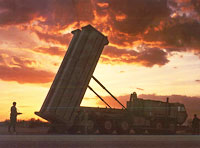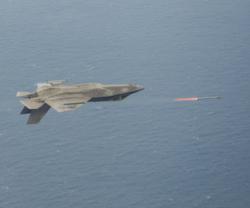All Components of 1st THAAD Battery Delivered to U.S. Army
08.03.2012 North America
Lockheed Martin has completed delivery of all hardware and components associated with the Terminal High Altitude Area Defense (THAAD) weapon system's first U.S. Army Battery.
In December, THAAD delivered its 24th interceptor, completing the first THAAD Battery (A-4 ADA). Two THAAD batteries have been activated at Fort Bliss, Texas. The first THAAD Battery (A-4 ADA Battery) was activated in May 2008. The second THAAD Battery (A-2 ADA Battery) was activated in October 2009. The Army anticipates activating a third Battery in late 2012.
“The Lockheed Martin THAAD team is proud to deliver this important capability to the warfighter,” said Mat Joyce, Vice President and Program Manager for the THAAD weapon system at Lockheed Martin.
“We remain focused on ensuring the THAAD system remains reliable, affordable and effective,” he added.
Since 2005, the THAAD program has successfully completed 12 flight tests, with nine-for-nine intercepts. The latest mission was an operational test conducted at the Pacific Missile Range Facility in Kauai, Hawaii, by THAAD soldiers from Alpha-4 (A-4), 11th Air Defense Artillery Imperial Brigade of the 32nd Army Air and Missile Defense Command. During that mission, two THAAD interceptors destroyed two different targets.
THAAD is the only missile defense system with the operational flexibility to intercept in both the endo- and exo-atmospheres to provide versatile capability to the warfighter. A key element of the nation's Ballistic Missile Defense System (BMDS), THAAD is a Missile Defense Agency program, with the program office located in Huntsville, Ala. The agency is developing the BMDS to defend the United States, its deployed forces and allies against short and medium range ballistic missiles in the terminal phase of flight.
Lockheed Martin is a world leader in systems integration and the development of air and missile defense systems and technologies, including the first operational hit-to-kill interceptor. It also has considerable experience in interceptor design and production, infrared seekers, command and control/battle management, and communications, precision pointing and tracking optics, as well as radar and signal processing. The company makes significant contributions to all major U.S. missile defense systems and participates in several global missile defense partnerships.
In December, THAAD delivered its 24th interceptor, completing the first THAAD Battery (A-4 ADA). Two THAAD batteries have been activated at Fort Bliss, Texas. The first THAAD Battery (A-4 ADA Battery) was activated in May 2008. The second THAAD Battery (A-2 ADA Battery) was activated in October 2009. The Army anticipates activating a third Battery in late 2012.
“The Lockheed Martin THAAD team is proud to deliver this important capability to the warfighter,” said Mat Joyce, Vice President and Program Manager for the THAAD weapon system at Lockheed Martin.
“We remain focused on ensuring the THAAD system remains reliable, affordable and effective,” he added.
Since 2005, the THAAD program has successfully completed 12 flight tests, with nine-for-nine intercepts. The latest mission was an operational test conducted at the Pacific Missile Range Facility in Kauai, Hawaii, by THAAD soldiers from Alpha-4 (A-4), 11th Air Defense Artillery Imperial Brigade of the 32nd Army Air and Missile Defense Command. During that mission, two THAAD interceptors destroyed two different targets.
THAAD is the only missile defense system with the operational flexibility to intercept in both the endo- and exo-atmospheres to provide versatile capability to the warfighter. A key element of the nation's Ballistic Missile Defense System (BMDS), THAAD is a Missile Defense Agency program, with the program office located in Huntsville, Ala. The agency is developing the BMDS to defend the United States, its deployed forces and allies against short and medium range ballistic missiles in the terminal phase of flight.
Lockheed Martin is a world leader in systems integration and the development of air and missile defense systems and technologies, including the first operational hit-to-kill interceptor. It also has considerable experience in interceptor design and production, infrared seekers, command and control/battle management, and communications, precision pointing and tracking optics, as well as radar and signal processing. The company makes significant contributions to all major U.S. missile defense systems and participates in several global missile defense partnerships.
Previous PostL-3 Wins Binocular Night Vision Devices Contract
Latest news
Latest events
Doha International Maritime Defence Exhibition & Conference (DIMDEX 2026)
19 - 22 Jan 2026Doha - QatarUMEX – SimTEX
20 - 22 Jan 2026ADNEC Centre Abu Dhabi, - United Arab EmiratesWorld Defense Show (WDS) 2026
08 - 12 Feb 2026Riyadh - Saudi ArabiaSAHA EXPO International Defence & Aerospace Exhibition
05 - 09 May 2026İstanbul Expo Center - Turkey






















